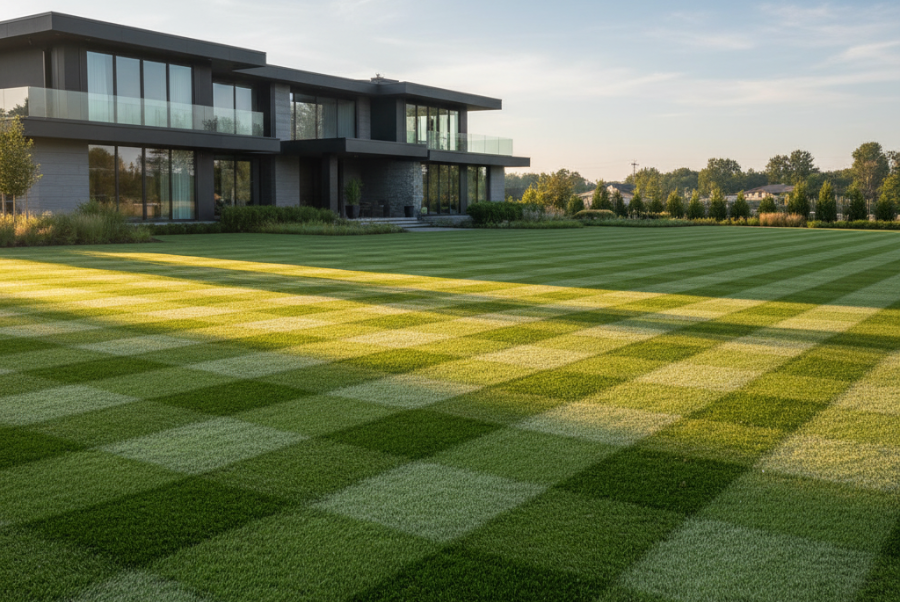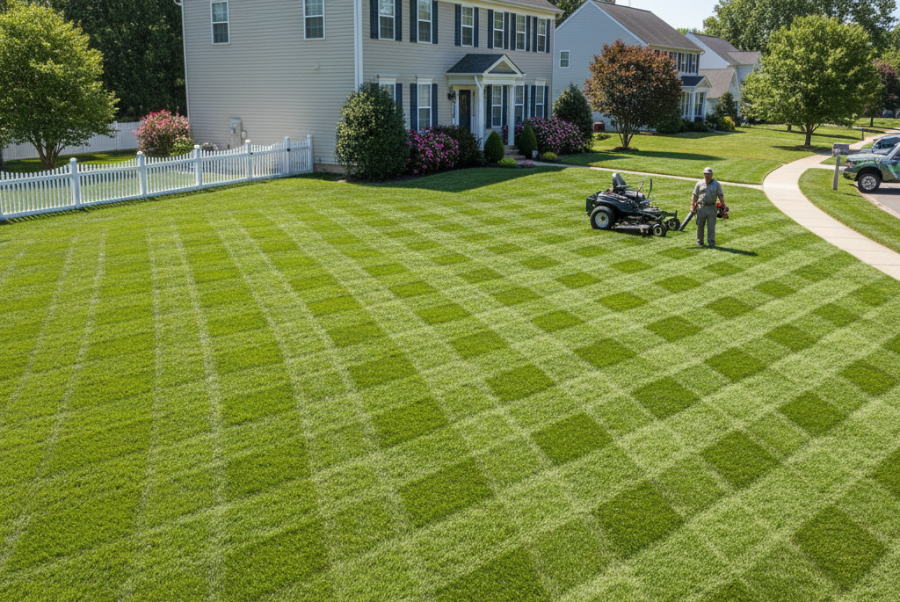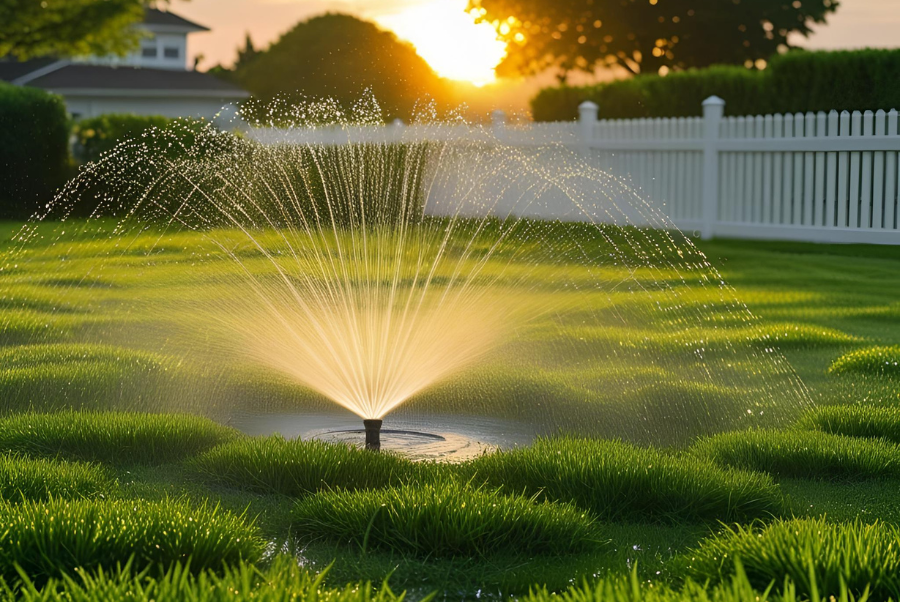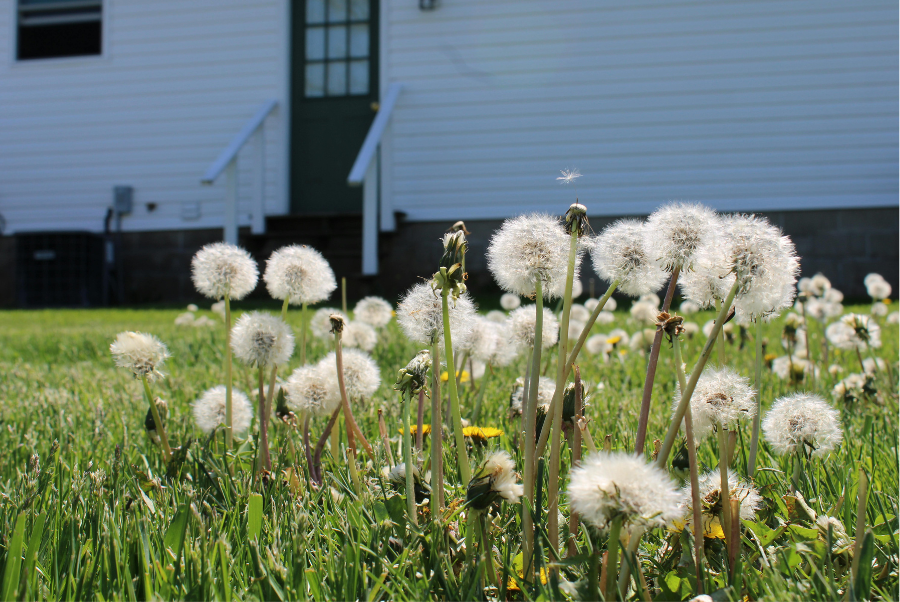
The Secret to a Lawn That Turns Heads in Coventry, RI
Ever drive through a neighborhood in Coventry, RI, and notice one lawn that just looks… perfect? The grass might not even be greener, but the way it’s mowed in clean, crisp lines or diamond shapes just makes it stand out. That’s not luck — it’s all about mowing patterns.
Many homeowners in Coventry don’t realize how much mowing patterns can change the entire look of their yard. Some think it’s only for golf courses or fancy homes, but with a little know-how, anyone can do it. Whether you live near Tiogue Lake, close to Flat River Reservoir, or right in Hopkins Hill, your lawn can look just as stunning with the right mowing tricks.
In this post, Doug Greenwood Landscaping Co. shares 5 eye-catching mowing patterns that add instant curb appeal — and why small changes in how you mow can make your lawn the star of the neighborhood.
Why Your Lawn Deserves a Pattern Upgrade
Doug Greenwood and his team have been keeping Coventry lawns sharp for years, and they’ll tell you this — patterns aren’t just for looks. They actually help your grass grow healthier by avoiding repeated wheel marks and encouraging upright growth.
And here’s the thing: even a simple pattern can make your property look “professionally done.” The kind that makes your neighbors stop and ask, “Who mows your lawn?”
If you want that kind of attention, these tips are for you.
Book an appointment with Doug Greenwood Landscaping Co. today for expert mowing and landscaping help: Book an Appointment
Make Sure Your Mower’s Ready for the Job
Before you try any mowing pattern, make sure your lawn mower is in good shape. A dull blade or uneven deck can ruin your lines and make the pattern look sloppy.
If you haven’t checked your mower in a while, now’s the time.
Here’s a quick pre-pattern checklist:
| Mower Maintenance Item | Why It Matters |
| Sharp Blade | Gives clean cuts, no tearing |
| Even Deck | Prevents uneven stripes |
| Tire Pressure | Keeps lines straight |
| Fuel & Oil Check | Keeps engine smooth |
| Clean Underside | Avoids clumping & missed spots |
If your mower’s cutting crooked or leaving patches, it might need a tune-up. You can learn how to get it in top shape in this guide on lawn mower maintenance in Coventry RI — a must-read before you start any mowing pattern.
See Where the Magic Happens
Doug Greenwood Landscaping Co. isn’t just another local landscaper — they’re right here in Coventry, caring for lawns across town every single week. Whether you’ve got a cozy front yard or a big backyard that faces the woods, they’ve got a pattern that fits.
Find them here:
The 5 Eye-Catching Mowing Patterns That Add Instant Curb Appeal
1. The Classic Stripes (Perfect for Coventry’s Suburban Yards)

This is the pattern you see on baseball fields — and it’s the easiest to pull off.
You just mow in straight lines, then mow back the other way, overlapping slightly each time.
Why it works:
- The light and dark effect happens because grass blades bend in opposite directions.
- It makes your lawn look larger and neater instantly.
Pro tip:
Keep your mower deck high enough so you’re not scalping your grass. Taller grass bends better and reflects more light.
If you want to take your stripes to the next level, combine this pattern with good mowing techniques. Check out these lawn mowing tips in Coventry RI to make your stripes sharper and longer-lasting.
2. The Checkerboard (For That “Ballpark” Look)

Want to make your yard look like it belongs in a pro baseball field? Try a checkerboard. It’s done by mowing stripes one way, then again at a 90-degree angle.
This pattern is great for:
- Large front yards near Woodland Manor
- Backyards that slope gently
- Lawns you want to impress guests with
To make the squares pop, mow in dry conditions and double-roll over the same lines for a stronger bend in the blades.
Why homeowners love it: It adds depth and geometry, creating a “finished” look that says, someone cares about this lawn.
3. The Diagonal Diamond (Best for Driveways & Corners)

This one’s a crowd favorite because it gives a three-dimensional effect. Start by mowing in diagonal lines (45°) across the lawn, then go over it again in the opposite direction to create diamonds.
Perfect for:
- Corner lots in Greene or Knotty Oak
- Lawns viewed from the street or driveway
This pattern draws the eye across your whole yard, making it look wider and more open.
Quick tip: Alternate the direction each week to prevent ruts and keep your grass healthy.
4. The Circular or Spiral Pattern (Fun for Family Yards)
If you’ve got kids or pets running around, this pattern keeps things playful. Start from a tree or garden bed in the center and mow in circles outward. It’s fun, it’s unique, and it’s easy on your mower’s turning radius.
This pattern is perfect around:
- Fire pits
- Pools
- Flower beds
Bonus: It’s great for avoiding uneven patches caused by repeated straight-line mowing.
Doug Greenwood Landscaping Co. often uses this pattern in residential yards near Tiogue Avenue for that smooth, “rolling lawn” look that feels relaxing and fresh.
5. The Wavy Lines (Creative and Casual)
For those who don’t want perfect geometry — this one’s for you. Wavy lines give your lawn a fun, free-flowing look. You just steer your mower in gentle curves back and forth.
It’s ideal for:
- Uneven lawns
- Smaller Coventry homes
- People who want a natural, artistic vibe
Just make sure the waves are consistent. Random zigzags can make your yard look messy.
Pro Tip: Mow on a day with bright sunlight to make the curves shine.
Why Mowing Patterns Actually Help Lawn Health
Most folks think mowing patterns are just for looks — but they actually improve grass health. Here’s how:
- Prevents Soil Compaction – Alternating directions helps avoid tire ruts.
- Improves Sunlight Coverage – Grass bends differently each time, exposing blades evenly.
- Encourages Upright Growth – Regular change in direction strengthens stems.
- Hides Imperfections – Smart patterns disguise patchy or uneven grass.
If you’re mowing too short or too often, you could be hurting your lawn’s roots. For a deep dive, check out our guide on avoiding common mowing mistakes in Coventry RI.
Quick Summary: Coventry’s Best Lawn Trick
Changing your mowing pattern isn’t complicated — but it’s one of the easiest ways to boost curb appeal instantly. From clean stripes to bold checkerboards, your yard can look “professionally done” in one afternoon.
And if you ever get stuck or just want it done perfectly, Doug Greenwood Landscaping Co. is ready to handle it for you.
FAQs About Mowing Patterns in Coventry, RI
Q1: Do mowing patterns damage my lawn?
Nope! In fact, changing up your mowing pattern helps prevent damage by reducing soil compaction and encouraging healthy growth.
Q2: How often should I change my mowing pattern?
Every 1–2 weeks during the growing season. This keeps your grass standing tall and prevents ruts.
Q3: Do I need a special mower for stripes or patterns?
Not really! A regular mower works fine — just make sure your blades are sharp and your deck is even.
Q4: What grass type works best for mowing patterns in Coventry, RI?
Cool-season grasses like Kentucky bluegrass and fescue show patterns beautifully.
Q5: Can mowing patterns help sell my home?
Absolutely! A crisp, patterned lawn adds instant curb appeal and makes your property look well-cared-for.
Q6: Are mowing patterns okay for sloped lawns?
Yes, but safety first! Avoid mowing directly across steep slopes. Go up and down instead.
Q7: Should I bag or mulch clippings after mowing?
Mulch whenever possible — it feeds your lawn naturally and keeps moisture balanced.
Conclusion: Your Coventry Lawn Deserves the Spotlight
At the end of the day, mowing isn’t just maintenance — it’s part of the design. The right mowing pattern makes your home look polished and intentional. Whether you’re near Flat River Reservoir or tucked away off Maple Valley Road, your lawn can look picture-perfect with a little planning.
Doug Greenwood Landscaping Co. loves helping homeowners in Coventry discover how simple mowing changes can transform their lawns. Whether it’s stripes, spirals, or diamonds — they’ll help you choose the one that fits your yard best.
Your yard deserves more than just a cut — it deserves care, creativity, and Coventry pride.
Let’s Make Your Lawn Coventry’s Favorite Yard
Ready to give your lawn that professional, eye-catching look?
Call Doug Greenwood Landscaping Co. today at (401) 336-6032 or
Book an Appointment Online
Doug and his team can help you design the perfect mowing pattern, maintain your grass, and keep your Coventry home looking its best — all season long.




